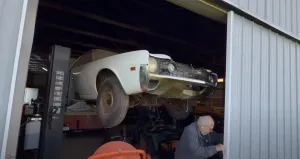A 1970 Buick Wildcat Convertible, a rarity with a powerful 455 V8 engine, nears its end, reflecting on a forgotten era.
The Buick Wildcat, once a proud symbol of American automotive design, finds itself at a crossroads. This 1970 Buick Wildcat Convertible, one of only 1,244 ever produced, is a rare gem in Buick's history, but decades of neglect have left it in a pitiful state, teetering on the edge of the crusher.
The Wildcat, produced between 1963 and 1970, was Buick’s attempt to blend full-size luxury with sporty performance. However, the Wildcat’s swan song in 1970 coincided with shifting consumer preferences and the rise of more aggressive muscle cars from other GM divisions. Despite receiving its most powerful engine yet—a 455 cubic-inch V8 delivering 370 horsepower and 510 lb-ft of torque—it wasn’t enough to save the model from extinction.
This particular Wildcat Convertible, originally Sherwood Green with a white top, has seen better days. Though once a striking example of open-air motoring, it now sits in a Texas salvage yard, its floorboards rusted away and its iconic V8 engine barely held in place. The car has endured decades of neglect, including a crash that led to its fender receiving heavy Bondo treatment and a repaint.
The rarity of this vehicle makes its condition all the more heartbreaking. Of the 1,244 Wildcat Convertibles produced in 1970, only 693 featured a white convertible top. The Custom trim, available in two- and four-door hardtops as well as this convertible, represented the pinnacle of Buick luxury for the time.
Even in its derelict state, the Wildcat commands a certain respect. Its Turbo Hydramatic 400 automatic transmission, a luxury option in its day, and its limited-slip differential rear axle were hallmarks of its performance pedigree. Unfortunately, most of this car’s parts, including its frame, have succumbed to rust and wear, leaving only a few salvageable components.
At $4,079 off the showroom floor in 1970, the Wildcat Convertible was a high-priced, head-turning machine weighing over two tons. While its days of glory are long past, the car remains a poignant reminder of an era when Buick dared to blend elegance with raw power.
Though its future likely lies in recycling rather than restoration, this Wildcat’s story underscores the importance of preserving automotive history and the fleeting nature of even the most glorious machines. For those who understand its legacy, it’s not just a car—it’s a chapter in the rich history of American motoring.





